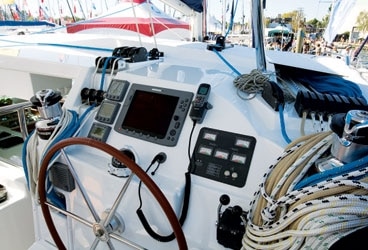
McGearyDiesel2
Lagoon, has experimented for several years with electric propulsion. The result, introduced in North America in the fall of 2006, is the Lagoon 420 Hybrid, the first model the company has designed from the outset to be driven exclusively by electric motors.
At the heart of the Lagoon system is a 21.5-kilowatt Onan AC generator and two 72-volt propulsion-battery banks, each made up of six 8D 12-volt batteries. On the American version, the generator delivers both 220 volts AC, to power a 72-volt-DC battery charger and high-draw AC appliances such as air-conditioning compressors, and 110-volt AC for outlets. When the batteries are fully charged, the boat can run silently, without the generator running, for about two hours at 75 percent of full power. When the batteries’ charge level drops below 80 percent, the generator automatically starts to prevent them from being depleted further. When the boat is sailing, the freewheeling propellers turn the electric motors, and they also become generators; at boat speeds of 4.5 knots and above, they recharge the batteries.
Getting under way for the first time on the Lagoon 420 Hybrid is a little spooky, especially if the batteries are fully charged and you dispense with the generator. The throttle levers are similar in appearance and feel to those used with diesel drives, but the response from the motors is different. Initially, the only sound comes from the swirl of the propellers. Because the motors deliver high torque as soon as they get power, the boat responds immediately, and until you get used to this, it’s easy to apply too much “throttle.” Unlike diesel propulsion, “idle speed” can be as slow as you want, because it’s not governed by the idling rpm of a diesel.
The generator is fitted in a dedicated enclosure that’s forward in the cockpit and against the bulkhead. It’s bigger than would normally be fitted on a boat of this size, but it does the duty of three diesel engines. When running, it’s no more noticeable than a normal generator installation.
If regeneration proves capable of providing all of the boat’s electrical needs on long passages under sail, it’ll be quite an asset, though it comes at the cost of drag caused by the propellers. The other side of the coin is the ability to run the generator and one or both propellers to boost boat speed at a far lower cost in fuel than with a standard diesel installation.
Jeremy McGeary is a CW contributing editor.








